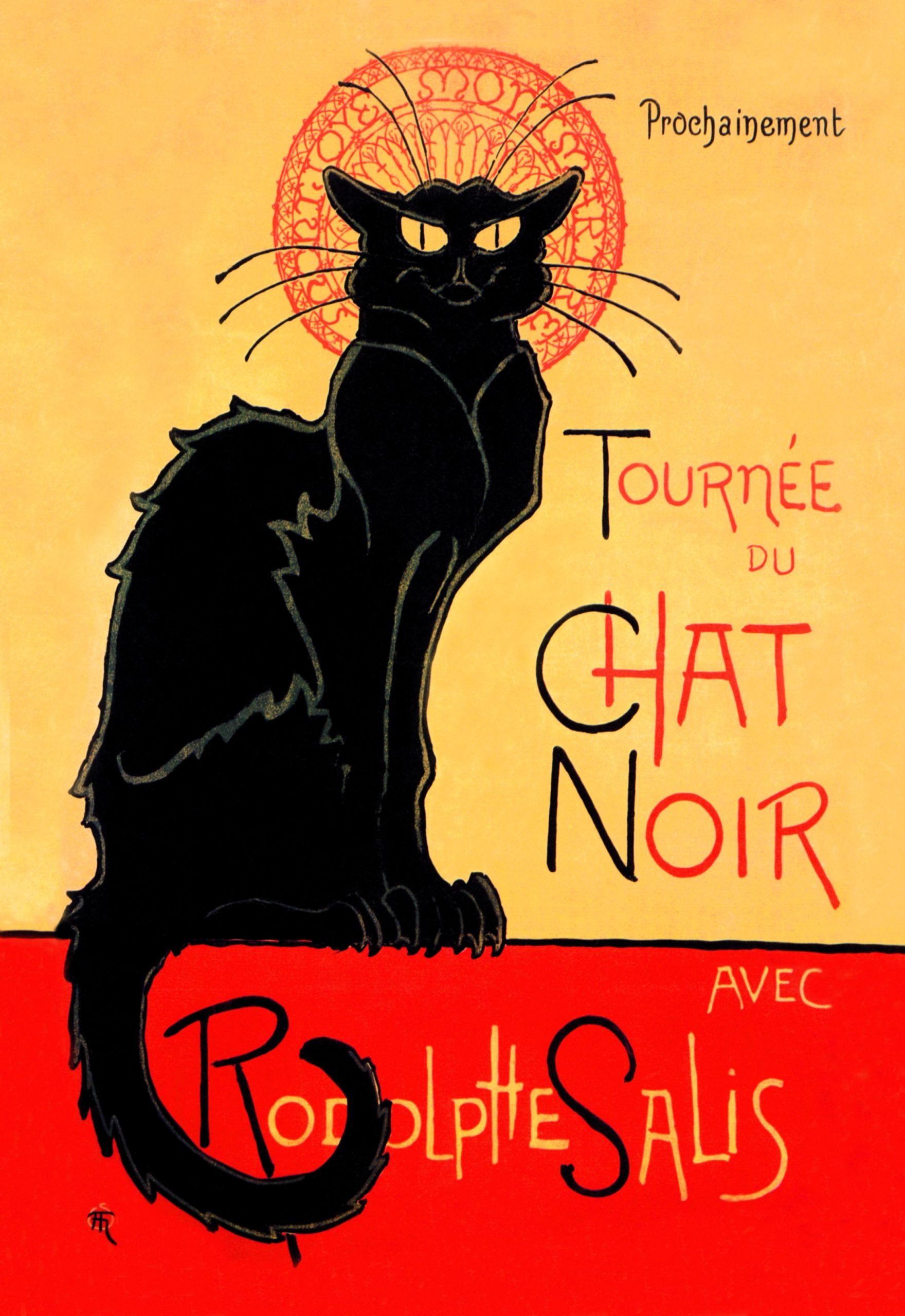
Anyone who has ever stepped foot in Paris or even passingly encountered French art has likely seen a version of the 19th-century poster Tournée du Chat Noir de Rodolphe Salis, or “Tour of Rodolphe Salis’ Chat Noir.” Iconic to the point of perhaps cliché, the motif has appeared on everything from totes and postcards to gift shop prints and mugs—frankly, you’d be more hard-pressed to find something it hasn’t appeared on.
The poster was created in 1896 for Le Chat Noir, a Parisian establishment founded by impresario Rodolphe Salis that is now considered by many as the first modern cabaret. A bohemian venue known for its nightly staged entertainment, Le Chat Noir attracted avant-garde writers, artists, and other creatives living and working in the Montmartre quarter of the city. What is less known about the celebrated Tournée du Chat Noir poster is that it was made by Théophile Alexandre Steinlen (1859–1923), an artist and Montmartre resident for whom cats were a true and undying passion.
Theophile Alexandre Steinlen, Summer: Cat on a Balustrade (1909). Photo: Heritage Art/Heritage Images via Getty Images.
Born in Lausanne, Switzerland, Steinlen moved to Paris in his early 20s where he remained for the rest of his life. Immersed in the vibrant art scene of Montmartre, fellow artist Adolphe Willette (1857–1926), who is famously one of the architects of the Moulin Rouge, introduced him to the regulars of Le Chat Noir, which ultimately led to Steinlen’s commission for a poster. While he participated in the Salon des Indépendants in the early 1890s, showing traditional landscapes, still lifes, and nudes, it is his graphic work that was and has remained the most popular and highlights his enduring interest in cats.
Theophile Alexandre Steinlen, À la Bodiniére (1894). Collection of the Art Institute of Chicago.
Tournée du Chat Noir is only one of the dozens of commercial pieces Steinlen made that feature cats front and center. An exhibition announcement from 1894 features a black and calico cat—the only figuration in the entire composition—curled up beside the show’s written details. Made a year later, an 1895 advertisement for French chocolates shows the artist’s wife and daughter, with a cat sitting on the table. In another work from the same year, this time instead for pasteurized milk (then a modern novelty) a little girl is shown sipping a saucer of milk while surrounded by three cats: a tabby, calico, and all black, with the latter two perhaps being the same models as the 1894 poster. And in 1898, he went so far as to produce the artists’ book Des chats, dessins sans paroles, comprised of a selection of his cat-centered designs. Even when he dabbled in sculpture, he was inclined towards making cat figures and figurines.
Théophile Alexandre Steinlen, left: Compagnie Française des Chocolats et des Thès (1895), right: Lait pur Sterilise (1895). Photo by Heritage Art/Heritage Images via Getty Images.
Steinlen was of the same generation as Alphonse Mucha (1860–1939) and Henri de Toulouse-Laurec (1864–1901), fellow Art Nouveau artists and illustrators recognized for their uniquely stylized work and taking inspiration from the vibrant, colorful world that was Paris at the end of the 19th century. Like Mucha and Toulouse-Lautrec, Steinlen created images that have come to define the aesthetic of the fin de siècle era. Though none have become as widely recognized as Tournée du Chat Noir, the small painting Pierrot and the Cat (1889) has recently become a source of social media meme fodder, showing a small child dressed as the classic French stock character clown (awkwardly) hoisting up a black cat.
Théophile Alexandre Steinlen, Pierrot and the Cat (1889). Wikimedia Commons.
While cats are pervasive throughout Steinlen’s oeuvre, it wasn’t just all-cats-all-the-time. The artist was deeply involved in leftist circles and activities and devoted to the rights of the working class. Influenced by his socialist beliefs, Steinlen created a prodigious number of sketches, drawings, prints, and ephemera that depicted the everyday life and struggles of the average working-class Parisian in the manner and tradition of social realism. He also contributed to widely circulated leftist periodicals such as La Feuille and Gil Blas. For Steinlen, his illustrations of everyday and marginalized people and communities were a form of activism, with his work’s dissemination helping bring the cause he held so dearly to life and broadening awareness.
Theophile Alexandre Steinlen, Housewife and Children Returning From the Laundry (1899). Collection of the Art Institute of Chicago.
In the latter part of his career, the outbreak of World War I saw his subject matter expand beyond ordinary people and life to include people directly impacted by the war, such as returning soldiers, grief-stricken families, and communities forced to evacuate. Through these compositions, Steinlen was able to distill the calamity of war to a human scale, highlighting the real and brutal effects on the individual level.
Theophile Alexandre Steinlen, For the Daughters of Soldiers Killed on the Field (1915). Collection of the Art Institute of Chicago.
The societal critiques inherent in much of his work led to him frequently using a pseudonym to avoid any potential political harassment. This didn’t curb him from creating hundreds of illustrations over his career, which today can be found in museums and institutions worldwide. Steinlen’s oeuvre has influenced numerous, subsequent generations of artists, including Pablo Picasso and Diego Rivera, the second of whom was particularly drawn by the use of posters and ephemera as a form of socially conscious engagement.
Though Tournée du chat noir will likely remain Steinlen’s most famous work—and one of the most famous of the 19th century on the whole—it is only a glimpse into the artist’s dynamic use of the medium, and, arguably more importantly, obsession with cats.